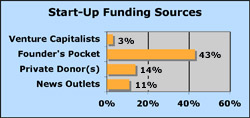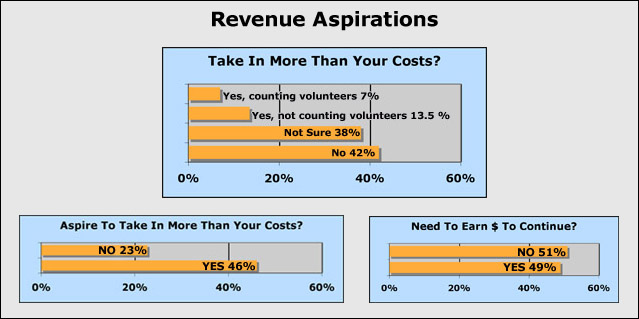While hyperlocal citizen sites have energetically created new editorial models, their business models remain deeply uncertain. It’s worth noting that many site operators who have been up for a year or two say they have put almost all of their time and energy into developing the editorial model, giving little time to earning revenues, attracting investments or making sites attractive to advertisers.
For the near future, the shoestring model will likely account for the greatest number of start-ups.
Nevertheless, business models are emerging across the spectrum from shoestring operations built on open-source software and volunteer labor, to investor-funded national syndicates of urban and suburban news-and-conversation sites. The field is filled with optimists who believe that citizen place sites, in a myriad of forms, will continue to spread across the country and the world.
For the near future, the shoestring model will likely account for the greatest number of start-ups. These are the sites that run on the energy and determination of a dogged entrepreneur or a cooperative group of citizens who share a passion to create conversations around issues that are not covered or can’t be thoroughly covered by mainstream media in its current configuration. In the great, shared environment of the Internet such sites are helping each other develop models for at least modest sustainability.
Many citizen journalists believe they are involved in a kind of bridge media between the traditional forms of news and local news delivery and a future where local news will be citizen-interactive – and where professional journalists will focus on the things they do best.
But in the Rocky Mountain West, in the D.C. suburbs, in small towns in Maine and across the country, new kinds of media companies are being constructed around core businesses of local citizen journalism and advertising. They’re experimenting with forms of search and with local shopping models that they hope will compete favorably, within their own towns and with such national behemoths as Google and Yahoo. The oldest of these, Village Soup, is 10 years old.
These new media companies are emerging in a couple of forms – as national syndication models, and as territorial businesses that are rooted in and reflect the priorities of one city or region.
The purest local citizen media sites, most prominently Backfence, have no professional reporters and depend on citizens to submit local news or items of interest or to blog – as well as to hang out and chat on their sites, and to shop with and rate advertisers. The Backfence model began in the D.C. suburbs, and had spread to 13 communities in Maryland, California and the Chicago suburbs by January 2007, when it announced a major restructuring as it charts a future course.
New West and Village Soup are also building new kinds of media companies around regional and hyperlocal journalism. Both pay professional journalists to generate original coverage of local issues, but they’re also highly interactive with citizens, and that interactivity extends to advertising.
Some of the sites that are household names in citizen media circles — Baristanet, WestportNow, H2otown - are developing as small businesses that may soon produce enough revenue to pay their owners full-time salaries. Several are investing by hiring part-time and full-time editorial and business staff members or by buying equipment for citizen photographers and videographers. WestportNow employs a full-time reporter/editor. Baristanet hired a part-time tech assistant and a local reporter. It’s not a newsroom, but it’s growth from where the sites were two years ago.
Lisa Williams has received offers from potential buyers of H2otown, but she’s refused to sell. “I don’t want to work for them because I think they wouldn’t let me make jokes,” she told an October 2006 Citizens Media Summit. “I think that a lot of people want the magic that they see in online sites, and then they want to control it. They’re actually kind of scared of it.” Williams said she will probably continue to run H2otown as a side enterprise to the business she is developing as a consultant for what she calls “place blogs.” She launched Placeblogger.com in December 2006.
In the nonprofit realm, Voice of San Diego and New Haven Independent offer high-quality local coverage produced by professional journalists, with assists from citizens. Voice of San Diego was launched by philanthropic investors and is developing a public radio-style model for member contributions. New Haven Independentsecures grants from foundations.
Legacy media companies are also in the race to build out hyperlocal citizen sites and reprint their content in free, home-delivered, ad-rich print editions. The web/print citizen journalism paradigm is profitable and growing at papers in smaller cities such as Bakersfield, California, and Columbia, Missouri. In Columbia, ad revenues increased after the content in its driveway, drop-free paper was replaced with content from the My Missourian citizen site. A product that was budgeted to produce 25 percent of the news operation’s revenues was producing 33 percent within a year of its launch.
In big cities, including Dallas and Denver, legacy newspapers are using citizen journalists to extend and enrich their suburban coverage. The local papers have hired and assigned staff editors to their citizen journalism sites, and communities around Dallas and Denver now have citizen sites instead of the newspapers’ zoned editions.
Many citizen journalists believe they are involved in a kind of bridge media between the traditional forms of news and local news delivery and a future where local news will be citizen-interactive – and where professional journalists will focus on the things they do best: Producing the kind of enterprise or investigative reporting that requires time, experience, travel and the backing of media companies that shoulder expenses and cut paychecks.
Time and again in conversation, citizen journalists assert they do a better job of describing the lived experiences of their towns than do professional reporters, especially strangers who pass through on their way to bigger and better journalism jobs. They say they know news at a block-by-block level that journalists can’t, and there are more of them available to report, reflect or respond to questions than any zoned newspaper section can employ. Even as they shy away from the “journalist” label, 79% of our survey respondents said they considered much of the content on their 104 sites to be “journalism.”
On the other hand, as Coastsider owner Barry Parr says he has found, print still has a hold on advertisers. Coastsider does not reverse publish, but Parr believes the operation will need to spin off a print edition before it can reach significant profitability in a town of just 30,000.
Survey Highlights
 The shoestring model of operations is borne out by our web survey. Respondents were pretty evenly split over whether the continued operations of their sites required them to earn revenue (yes, 49%; no 51%). If that sounds odd, consider that 29% of the respondents said it cost them less than $100 to launch their site; and it cost less than $1,000 for another 14%.
The shoestring model of operations is borne out by our web survey. Respondents were pretty evenly split over whether the continued operations of their sites required them to earn revenue (yes, 49%; no 51%). If that sounds odd, consider that 29% of the respondents said it cost them less than $100 to launch their site; and it cost less than $1,000 for another 14%.
Indeed, start-up money, for 43% of the sites in our survey, came right out of the founders’ own pockets. Existing news organizations provided funding for 11% of the sites, private donors for 14%, while venture capital funded fewer than 3% of the respondents’ sites.
For those sites that are generating some revenues, advertising is the primary source for 48% of the respondents; community and corporate sponsors generate revenue for 25%; individual donors for 16%; and grants for almost 11%. Fewer than 5% rely on subscription income.
Some sites, such as OlyBlog, state matter-of-factly: “We accept no advertising or institutional support. All costs are covered out of pocket. If you like what we’re doing, throw a few bucks in the tip jar.”
Do their sites take in more revenue than it costs to operate? About 42% said no; 38% didn’t know. Almost 14% of those sites that do take in more than their operating costs said this was true only if volunteer contributions are not counted. Only 7% – 10 sites out of 141 replying – said that their operating costs were covered, even if volunteer contributions are counted as a cost.

